Hi all,
I'm building speakers with 3 drivers (treble, mid, bass) and bass port.
There's a multitude of info. here on various x-over designs, I'm looking for a passive system with linear response that might be avilable as a kit or at least based on an existing PCB. The speakers will be ~150w, 8 Ohms.
Words mentioned, I've seen 'eliptical' plus various 'orders'...
Any takers?
I'm building speakers with 3 drivers (treble, mid, bass) and bass port.
There's a multitude of info. here on various x-over designs, I'm looking for a passive system with linear response that might be avilable as a kit or at least based on an existing PCB. The speakers will be ~150w, 8 Ohms.
Words mentioned, I've seen 'eliptical' plus various 'orders'...
Any takers?
You are leaving a lot in the open. Budget, goal, listening environment, required levels, DIY skills, quality aspirations, aesthetic aspects...
Then you jump to crossovers. And you seem clueless to me. My suggestion would be: search for a proper design you like, the various places on the internet offer a wealth of designs. In case of doubt, start a topic here about your choice (although that sometimes ends up confusing). If possible, go listen or bring some speakers home and try them.
Places to start are the sites of Troels Gravesen, Tony Gee, Paul Carmody, Curt Campbell. Maybe look for kits with 8" to 10" woofers, 4" to 5" cone midranges and 1" tweeters. These designs often turn out quite well because design aspects like directivity and power distribution fall into place automatically in such speakers.
Then you jump to crossovers. And you seem clueless to me. My suggestion would be: search for a proper design you like, the various places on the internet offer a wealth of designs. In case of doubt, start a topic here about your choice (although that sometimes ends up confusing). If possible, go listen or bring some speakers home and try them.
Places to start are the sites of Troels Gravesen, Tony Gee, Paul Carmody, Curt Campbell. Maybe look for kits with 8" to 10" woofers, 4" to 5" cone midranges and 1" tweeters. These designs often turn out quite well because design aspects like directivity and power distribution fall into place automatically in such speakers.
+1 on kits; they designers already did the hard part; they spent a lot of time tweaking the design so you don't have to.
I do "usually" prefer 3-ways over 2-ways. But, you could do a smaller 2-way then add a larger woofer or sub-woofer later.
I do "usually" prefer 3-ways over 2-ways. But, you could do a smaller 2-way then add a larger woofer or sub-woofer later.
You are leaving a lot in the open. Budget, goal, listening environment, required levels, DIY skills, quality aspirations, aesthetic aspects...
Then you jump to crossovers. And you seem clueless to me. My suggestion would be: search for a proper design you like, the various places on the internet offer a wealth of designs. In case of doubt, start a topic here about your choice (although that sometimes ends up confusing). If possible, go listen or bring some speakers home and try them.
Places to start are the sites of Troels Gravesen, Tony Gee, Paul Carmody, Curt Campbell. Maybe look for kits with 8" to 10" woofers, 4" to 5" cone midranges and 1" tweeters. These designs often turn out quite well because design aspects like directivity and power distribution fall into place automatically in such speakers.
Thanks for your reply - my query relates just to the crossovers, more particularly to the types of crossovers available. I already have the drivers (they were free to me) being Monacor SPH-250KE bass, SPH102-KPE mid and SEAS H0881-06 tweeter. Your suggestions fit those drivers. The enclosures are in manufacture aiming for a cabinet resonant frequency of 30Hz, bass driver has a resonant frequency of 23Hz. They are ported.
My budget for crossovers is not infinite, however I only want to buy them once. My listening environment is home living room, music type from punk to jazz to classical to female vocalists and then everything else!
Doing a quick check on the woofer, it has a pretty small Xmas of +/-4.75mm and using an online calculator needs a 100litre box to get 30hz, this has a slight bass hump (flat is 30hz with 216litres!), port 7,5cm diam by 11cm long. The benefit is that it is quite sensitive at 90dB/w/m.
You say the speakers will be 8ohm and 150w. Even though the speaker drivers may be nominally 8 ohm the finished soeaker will likely fluctuate between 3.5 and 20 ohms. The power handling of the speaker will be determined by the woofer and when it reaches xmax or possibly xlim if you are brave, you can simulate this in WinISD plus it will give you port velocity to make sure it is not chuffing.
As most on here will advise - you need to measure the separate drivers in the box you are building then use a sim programme to design the crossover and then build, tweak, repeat!
You say the speakers will be 8ohm and 150w. Even though the speaker drivers may be nominally 8 ohm the finished soeaker will likely fluctuate between 3.5 and 20 ohms. The power handling of the speaker will be determined by the woofer and when it reaches xmax or possibly xlim if you are brave, you can simulate this in WinISD plus it will give you port velocity to make sure it is not chuffing.
As most on here will advise - you need to measure the separate drivers in the box you are building then use a sim programme to design the crossover and then build, tweak, repeat!
Last edited:
Thanks for the comments. As mentioned, I'm not looking for comments on speaker cabinet size or any other aspect of construction as that's already finalised.
What I'm after are comments on the selection of type of crossover. Concentrating on crossovers, there's a number of different deisgns debated in various threads. Various online calculators churn out values for inductors and capacitors together with the crossover frequencies.
I'm more than capable of soldering, but I don't want to go down the path of making my own PCB hence preference for existing kits.
Can anyone specifically comment on crossover type, eg eliptical, Butterworth, different orders of filter and their suitability/characteristics for use in a 3-way system, that would be very much appreciated. Thanks 🙂
What I'm after are comments on the selection of type of crossover. Concentrating on crossovers, there's a number of different deisgns debated in various threads. Various online calculators churn out values for inductors and capacitors together with the crossover frequencies.
I'm more than capable of soldering, but I don't want to go down the path of making my own PCB hence preference for existing kits.
Can anyone specifically comment on crossover type, eg eliptical, Butterworth, different orders of filter and their suitability/characteristics for use in a 3-way system, that would be very much appreciated. Thanks 🙂
Here is a calculator I use. When I am unsure; I sometimes start with a 2nd order Bessel. An example of why follows.
Say you want low pass (LP), 2nd order around 850 Hz (assume 8 Ohms). BE has an inductor of about 2.0 mH but also, so do BW and LR. This is close enough; then you can easily add or take away capacitance as a way of fine tuning.
I have been doing this for over 50 years so I have an intuition about what works and where to start. If you don't have much experience but are willing to experiment; this is certainly one technique. I use alligator clip leads as a quick means of swapping components.
One tip is to look at the impedance curves and don't assume the impedance is a constant (it's NOT).
I prefer 1st order X/O myself when possible but that takes very careful matching of drivers.
Do you have any books such as V Dickason Loudspeaker Design Cookbook? It would be better if you did some detailed reading before you start buying parts.
I buy cheap parts to start with sometimes knowing I can upgrade to better quality once I get a final X/O design nailed down.
Say you want low pass (LP), 2nd order around 850 Hz (assume 8 Ohms). BE has an inductor of about 2.0 mH but also, so do BW and LR. This is close enough; then you can easily add or take away capacitance as a way of fine tuning.
I have been doing this for over 50 years so I have an intuition about what works and where to start. If you don't have much experience but are willing to experiment; this is certainly one technique. I use alligator clip leads as a quick means of swapping components.
One tip is to look at the impedance curves and don't assume the impedance is a constant (it's NOT).
I prefer 1st order X/O myself when possible but that takes very careful matching of drivers.
Do you have any books such as V Dickason Loudspeaker Design Cookbook? It would be better if you did some detailed reading before you start buying parts.
I buy cheap parts to start with sometimes knowing I can upgrade to better quality once I get a final X/O design nailed down.
Mission,
To use a car analogy, what you're doing here is saying "I'm building a car. Which gearbox should I install?" A lot of information is required before that question can be answered.
The different crossover topologies each have advantages and disadvantages. Have a look at Rod Elliott's articles for a good overview.
The crossover is as important as the choice of drive units in terms of getting a great-sounding speaker at the end. I once picked up a pair of speakers (they were supposed to have amplifiers built-in, but were so cheap I didn't mind they were missing) which had a series cap for the tweeter and nothing else. Rough upper midrange, bright tonal balance, limited power handling before harmonic distortion was evident.
They're Fostex PM04, if you're interested.
As a try-it-and-see, I measured the drivers in the cabinets, and designed a crossover which integrated the drivers nicely and gave a flat response (my personal preference - others prefer a declining HF response for various reasons).
The results were pretty good, especially at lower levels. However, if I turned it up a bit, the harmonic distortion was evident again.
Back to the drawing board on the crossover. I had used a 2nd order highpass at 2.2kHz for the tweeter, but apparently that 0.75" dome requires a bit of babying, so I went up to 2.7kHz, 3rd order. The on-axis response of that was still nice and flat, but the off-axis response wasn't quite as smooth.
With the new highpass in place (and the woofer's lowpass tweaked accordingly), I could get those speakers to astonishing levels (well, for the size of the speaker) before they complained: the 4" woofer was the limiting factor, even on program material with little LF content.
At that point, I called it good. I could've gone further and installed new drivers, built better cabinets etc etc, but they were just something to play around with for a while and learn some new tricks.
So, I'd recommend that you pick up some measurement gear and start trying things for yourself. There's lots of free software to get you started.
Chris
To use a car analogy, what you're doing here is saying "I'm building a car. Which gearbox should I install?" A lot of information is required before that question can be answered.
The different crossover topologies each have advantages and disadvantages. Have a look at Rod Elliott's articles for a good overview.
The crossover is as important as the choice of drive units in terms of getting a great-sounding speaker at the end. I once picked up a pair of speakers (they were supposed to have amplifiers built-in, but were so cheap I didn't mind they were missing) which had a series cap for the tweeter and nothing else. Rough upper midrange, bright tonal balance, limited power handling before harmonic distortion was evident.
They're Fostex PM04, if you're interested.
As a try-it-and-see, I measured the drivers in the cabinets, and designed a crossover which integrated the drivers nicely and gave a flat response (my personal preference - others prefer a declining HF response for various reasons).
The results were pretty good, especially at lower levels. However, if I turned it up a bit, the harmonic distortion was evident again.
Back to the drawing board on the crossover. I had used a 2nd order highpass at 2.2kHz for the tweeter, but apparently that 0.75" dome requires a bit of babying, so I went up to 2.7kHz, 3rd order. The on-axis response of that was still nice and flat, but the off-axis response wasn't quite as smooth.
With the new highpass in place (and the woofer's lowpass tweaked accordingly), I could get those speakers to astonishing levels (well, for the size of the speaker) before they complained: the 4" woofer was the limiting factor, even on program material with little LF content.
At that point, I called it good. I could've gone further and installed new drivers, built better cabinets etc etc, but they were just something to play around with for a while and learn some new tricks.
So, I'd recommend that you pick up some measurement gear and start trying things for yourself. There's lots of free software to get you started.
Chris
I'm more than capable of soldering, but I don't want to go down the path of making my own PCB hence preference for existing kits.
Typically crossovers don't use PCB, instead point to point is much more common way to build. The result will not be good if you buy some general purpose crossover. Crossovers are designed just for the drivers and cabinet that will be used.
My best guess is mid- woofer crossover at the baffle step frequency, 2nd order LR,
mid-tweeter crossover at 3 Khz, 2nd order on the mid, 3rd order on the tweeter with the tweeter inverted and ~ 3dB attenuation. The mid has a rising response from 1Khz which may need to be dealt with...
mid-tweeter crossover at 3 Khz, 2nd order on the mid, 3rd order on the tweeter with the tweeter inverted and ~ 3dB attenuation. The mid has a rising response from 1Khz which may need to be dealt with...
Get a measurement mic and together with REW you'll see what you're doing
and the actions you should take,
otherwise its guessing and mostly wrong.
and the actions you should take,
otherwise its guessing and mostly wrong.
There is an off-the-shelf that might work here, the Visaton HW 3/130 NG :
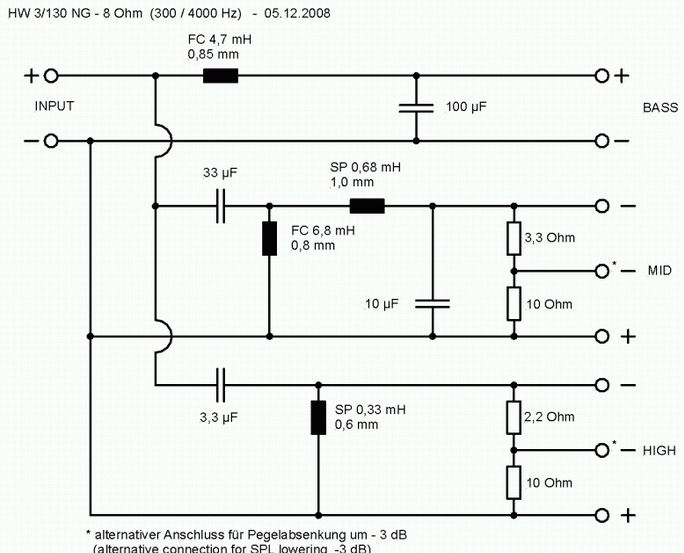
HW 3/130 NG - 8 Ohm | Visaton
Visaton HW 3/130 NG - 8 Ohm – Impact Audio
Compare with these projects to see how it works:
Poor Man'
SEAS-3-Way-Classic
You can set your project up in Software | Visaton with similar visaton drivers to get a feel for it all. The W250S, W100S and SC10N might be close to what you have. You can fiddle around with resistors easily enough. Probably move them around too. Looks quite a nice PCB to play with.
Your 8 ohm 10" bass, 4" mid and SEAS 27TFFC look quite promising. Hope it helps.
HW 3/130 NG - 8 Ohm | Visaton
Visaton HW 3/130 NG - 8 Ohm – Impact Audio
Compare with these projects to see how it works:
Poor Man'
SEAS-3-Way-Classic
You can set your project up in Software | Visaton with similar visaton drivers to get a feel for it all. The W250S, W100S and SC10N might be close to what you have. You can fiddle around with resistors easily enough. Probably move them around too. Looks quite a nice PCB to play with.
Your 8 ohm 10" bass, 4" mid and SEAS 27TFFC look quite promising. Hope it helps.
Last edited:
Steve - many thanks for your thoughts and links. I'll use Boxsim with the driver parameters and see what I get.
I just dug up an old post of mine on this topic:
Midrange attenuation l-pad or single resistor?
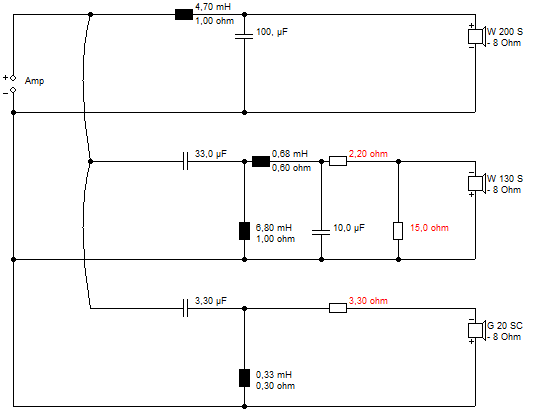
That's how 8" plus 5" plus 3/4" worked out for a flattish response.
Not sure this image is the same circuit but it usually turns out like this:
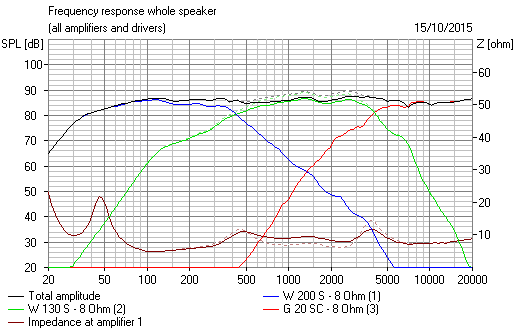
Now you do a bit of guesswork on loudness by comparing the mostly similar drivers.
These projects can be quickly imported into Boxsim projekte folder and modified in minutes. Swap drivers and components. Boxsim will optimise any components marked in red.
3 Wege – Boxsim Projektdatenbank
Midrange attenuation l-pad or single resistor?
That's how 8" plus 5" plus 3/4" worked out for a flattish response.
Not sure this image is the same circuit but it usually turns out like this:
Now you do a bit of guesswork on loudness by comparing the mostly similar drivers.
These projects can be quickly imported into Boxsim projekte folder and modified in minutes. Swap drivers and components. Boxsim will optimise any components marked in red.
3 Wege – Boxsim Projektdatenbank
The first problem you have is your Monacor SPH-250KE. It is optimised for a sealed not vented enclosure. You'll find the tuning frequency is much lower than optimal and port length also too long if you go vented. Try it in WinISD and you'll see what I mean.
If we assume a Qtc 0.71 for a closed box, you'll need 105L - so not a small enclosure. Given you only have 4.75mm xmax - you are going to reach this at only 9 watts. yes that's right.
Vented doesn't save you here. you also only get about 9 watts before you hit xmax.
This means a max SPL ~ 99dB before you reach the limits of the woofer.
Whether the above is enough for your music type and listening levels.. up to you
If we assume a Qtc 0.71 for a closed box, you'll need 105L - so not a small enclosure. Given you only have 4.75mm xmax - you are going to reach this at only 9 watts. yes that's right.
Vented doesn't save you here. you also only get about 9 watts before you hit xmax.
This means a max SPL ~ 99dB before you reach the limits of the woofer.
Whether the above is enough for your music type and listening levels.. up to you
I think you are being overly gloomy there Dave Bullet. 😀
Vas of 200L, Qts of 0.41 on a 10" driver. The exact calculation is about 100L as you say, but everybody uses undersized boxes, closed or reflex. Usually about 50L is OK with 10" bass.
There is a point where it just kinda works. And smaller boxes have that property called WAF. Because you usually have to get it past the significant other.
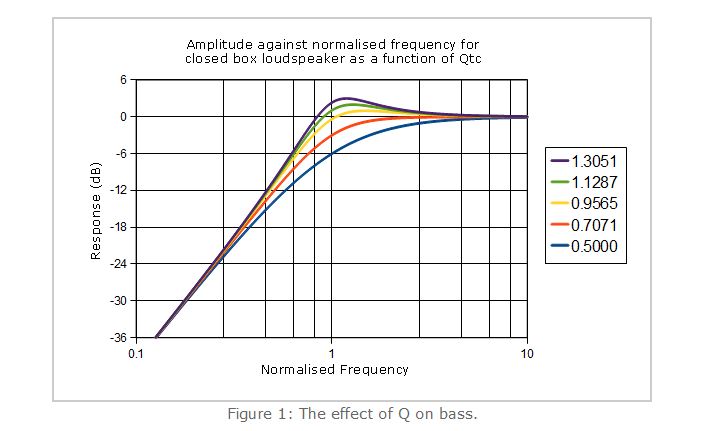
How phase aligned three ways work:
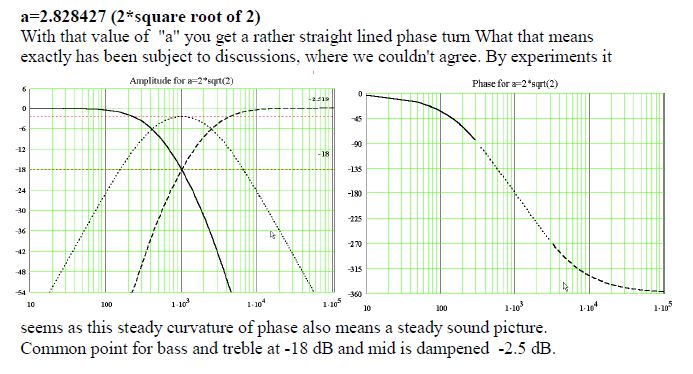
Vas of 200L, Qts of 0.41 on a 10" driver. The exact calculation is about 100L as you say, but everybody uses undersized boxes, closed or reflex. Usually about 50L is OK with 10" bass.
There is a point where it just kinda works. And smaller boxes have that property called WAF. Because you usually have to get it past the significant other.
How phase aligned three ways work:
These schematics contain an often made mistake. First stage should cross over between low an mid/high. Then this hi/mid stream should be crossed between high and mid.
The schematics shown will lead to a phase error between mid and hi.
The schematics shown will lead to a phase error between mid and hi.
I think you are being overly gloomy there Dave Bullet. 😀
I might seem negative. But that is not my intent. It's to let the OP know the limitations of the driver choice to see if they want to change before committing down a path leading to disappointment.
To the OP - without factory frequency response measurements and impedance data or better still your own in-box measurements... and ability to simulate a crossover, you'll really be producing a sub-optimal design. If you rely on copying and pasting on-line crossover component calculator values or using "standard" 3 way crossovers with fixed Fc and assumed flat (never the case) impedance.
- Home
- Loudspeakers
- Multi-Way
- Three-way crossover design